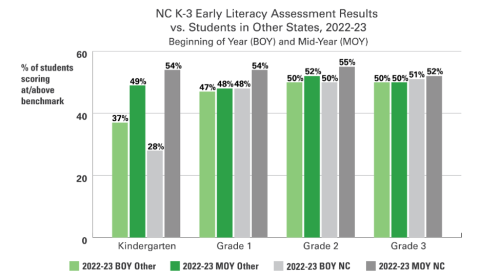
Special to Iredell Free News
RALEIGH — Students in early elementary grades in North Carolina public schools continue to show gains in literacy skills, according to results of a key assessment administered during the middle of the current school year.
The percentage of North Carolina students on track in each grade – kindergarten through third – performing at or above the benchmark score of the 2022-2023 school year was both higher than assessment results from the beginning of the school year and also higher than results from states or districts using the same assessment.
The gains by North Carolina students were achieved during the second full year of a far-reaching statewide initiative to support elementary school teachers with extensive training in instruction based on the “science of reading,” a phonics-based approach with strong evidence of effectiveness.
Additionally, North Carolina’s statewide results show that fewer students mid-year were well below assessment benchmarks and in need of intensive intervention. Disaggregated results show that white, Asian, Black, Hispanic, and American Indian student groups all made gains from the beginning of the school year, and all except Hispanic and American Indian students outpaced other states and districts using the same assessment. Yet the mid-year gains made by all student groups in North Carolina were greater than students given the same assessment in other states.
State education leaders are encouraged by the latest assessment outcomes, which they say indicate that schools across the state are implementing science of reading-based practices even as many teachers are still learning about the instructional approach through the two-year professional development program, Language Essentials for Teachers of Reading and Spelling, or LETRS.
Improving early literacy outcomes has been a core tenant for the State Superintendent of Public Instruction Catherine Truitt and has been highlighted in her four-year strategic plan called Operation Polaris. Truitt said she believes the latest results are strong evidence that the state’s commitment to instruction informed by the “science of reading” is helping more students gain the foundational literacy skills needed to master reading.
“On top of all the other hard work that teachers do in their classrooms every day, they’ve been spending many hours outside the classroom learning to retool their instructional practices,” Truitt said. “They’re to be commended, as their work has helped improve literacy proficiency and outcomes for students across the state.”

The early literacy screener, DIBELS 8 (Dynamic Indicators of Basic Early Literacy Skills), an updated version of the previous DIBELS assessment from mCLASS, is based on the science of reading and measures students’ risk level on component skills involved in reading such as phonemic awareness and phonics. The tool was used with all kindergarten through third grade students in North Carolina for the first time in the 2021-2022 school year.
The latest assessment results also showed that North Carolina students in all four grades made greater mid-year gains than students in other states using the same assessment. Among North Carolina kindergartners, for example, where the largest gain of the four grades was measured from the beginning of the year– the percentage of students meeting the benchmark almost doubled, climbing from 28% to 56%. Among first-graders in other jurisdictions nationally who took the same assessment, the percentage difference was 12 points: 37% at the beginning of the year and 49% mid-year.
In the other three grade levels, North Carolina’s mid-year gains also outpaced the aggregate gains of students in other districts in the nation taking the same assessment. In addition, when compared to other states and districts, the mid-year results showed that fewer North Carolina students were at risk or needing intensive intervention. Only among third-graders in the state did the mid-year assessment find a slightly higher percentage of students needing intensive intervention from the beginning of the school year, which was also the case for students outside the state.
North Carolina’s results were compared with those of 1.6 million K-3 students elsewhere in the nation whose literacy skills are measured with the same assessment, according to Amplify, the education company that provides the mCLASS assessment under contract with the Department of Public Instruction.
The updated assessment that North Carolina schools are using since the 2021-2022 school year more closely matches the science of reading’s emphasis on five critical components: phonemic awareness, phonics, fluency, vocabulary, and comprehension. Consequently, comparisons to previous years are not compatible.
Additionally, the assessment results are not comparable to the state’s end-of-grade reading tests, which are administered beginning in the third grade. Those exams measure whether a student has mastered grade-level standards, from a basic level to more rigorous comprehension, while the mCLASS assessment measures the essential, foundational skills that students need to become successful readers.
Teachers administer the mCLASS assessment with students individually at the beginning, middle and end of the school year, and are encouraged to use it between established benchmarks to monitor student progress. In addition to student progress monitoring data, the various component skills measured by mCLASS also help guide teachers in their literacy instruction and interventions.



